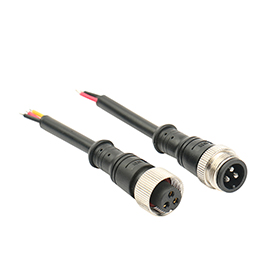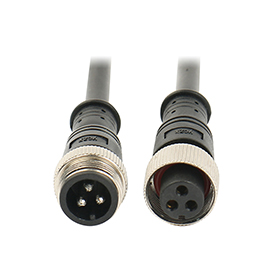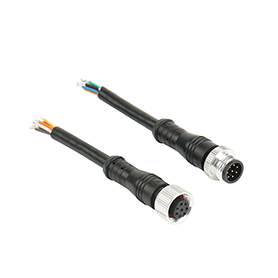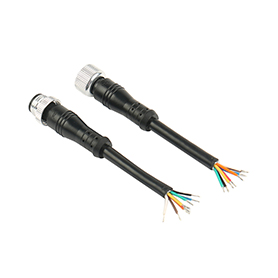News


News

Cylindrical connector manufacturing process: the whole process from raw materials to finished produc
Release time:2024-10-28
viewed:453
As an indispensable component in electronic equipment, the design and manufacturing process of cylindrical connectors involves multiple complex links. The following introduces the design principles and methods of cylindrical connectors, including contact design, shell design, sealing design, etc.; introduces its manufacturing process and process, including raw material selection, processing, assembly, testing and other links, and analyzes the problems encountered in the design and manufacturing process and the corresponding solutions.

1. Contact design
The contact is one of the most critical components in the connector, responsible for signal transmission and current flow. The contact design of cylindrical connectors needs to pay special attention to the following points:
Material selection: The contact is usually made of copper alloy or gold-plated copper alloy because these materials have good conductivity and corrosion resistance.
Terminal shape: The contact terminal of the cylindrical connector is usually designed to be cylindrical or needle-shaped to ensure good contact and plug-in performance.
Differential signal terminal: In high-speed data transmission, differential signal terminals can effectively reduce electromagnetic interference (EMI) and radio frequency interference (RFI) and improve signal transmission quality.
2. Shell design
The design of the shell not only affects the appearance of the connector, but also directly affects its mechanical properties and protection level.
Material selection: The shell is usually made of plastic or metal. The plastic shell has the advantages of light weight, low cost, and easy processing, while the metal shell has higher strength and protection level.
Structural design: The design of the cylindrical shell needs to consider factors such as plug-in force, locking mechanism, and foolproof structure to ensure the reliability and ease of use of the connector.
Sealing design: For connectors that need to be waterproof and dustproof, the shell design needs to include sealing structures such as O-rings, sealants, etc.
3. Sealing design
Sealing design is the key to ensuring that the connector works normally in harsh environments.
Sealing materials: Commonly used sealing materials include rubber, silicone, polytetrafluoroethylene (PTFE), etc. These materials have good elasticity and corrosion resistance.
Sealing structure: The sealing structure of the cylindrical connector usually includes radial sealing and axial sealing. The radial sealing is achieved by O-rings or sealing rings, and the axial sealing is achieved by sealing pads or sealants.
Environmental adaptability: The sealing design needs to consider the working environment of the connector, such as temperature, humidity, pressure and other factors, to ensure the stability and reliability of the sealing performance.

1. Raw material selection
The manufacturing of connectors requires a lot of material support, including plastics, metals, electrode alloys, etc.
Plastic materials: usually used to manufacture housings and insulating parts, such as polycarbonate (PC), nylon (PA), polypropylene (PP), etc.
Metal materials: used to manufacture contacts, housings and other parts, such as copper alloys, stainless steel, aluminum alloys, etc.
Electrode alloys: used to manufacture contacts with special requirements, such as gold-plated copper alloys.
2. Processing
The processing of connectors includes forming and welding of metal materials, injection molding of plastic materials, etc.
Metal forming: metal materials are processed into the required shape and size by stamping, forging, casting and other methods.
Injection molding: the plastic is melted and injected into the mold, and the required plastic parts are obtained after cooling.
Welding: for parts that need to be welded, such as contacts and housings, resistance welding, laser welding and other methods are usually used.
3. Assembly
The assembly process of the connector is to assemble the various parts together according to the design requirements to form the final connector product.
Parts preparation: The processed parts are cleaned, deburred, etc. to ensure the assembly quality.
Assembly process: According to the design drawings, the parts are assembled one by one, including the insertion of contacts, the assembly of the shell, the installation of seals, etc.
Quality inspection: During the assembly process, multiple quality inspections are required to ensure that the quality of each step meets the requirements.
4. Testing
After the connector is manufactured, it needs to be fully tested to ensure its performance and quality.
Electrical performance test: Test the electrical properties of the connector such as contact resistance, insulation resistance, and withstand voltage.
Mechanical performance test: Test the mechanical properties of the connector such as plug-in force, locking force, and vibration resistance.
Environmental adaptability test: Test the performance stability of the connector under high temperature, low temperature, humidity, etc.

1. Improper mold design
Improper mold design may cause various problems in the connector during the molding process, such as film sheets, burrs, warping, etc.
Solution: Optimize mold design, increase the thickness and make the thickness uniform, select appropriate plastics and molding processes, and improve mold accuracy and strength.
2. Improper material selection
Improper material selection may cause the connector to degrade or be damaged during use.
Solution: According to the use environment and requirements of the connector, select appropriate materials, such as materials with high temperature resistance, corrosion resistance, high strength and other characteristics.
3. Insufficient processing accuracy
Insufficient processing accuracy may cause the size and shape of the connector's contacts, shells and other components to not meet the design requirements.
Solution: Improve processing accuracy and use advanced processing equipment and processes, such as CNC machining, laser cutting, etc.
4. Assembly quality problems
Assembly quality problems may cause the performance of the connector to be unstable or fail.
Solution: Strengthen quality control during the assembly process, use automated assembly equipment and processes, and improve assembly accuracy and efficiency.
5. Insufficient testing
Insufficient testing may cause unknown performance problems in the connector during use.
Solution: Conduct comprehensive testing, including electrical performance testing, mechanical performance testing, environmental adaptability testing, etc., to ensure that the performance and quality of the connector meet the requirements.

1. Optimize design
Improve the performance and reliability of connectors by optimizing design.
Use advanced design software and tools: such as CAD, CAE, etc., for precise design and simulation analysis.
Learn from mature design experience: refer to mature design cases and experience in the industry to avoid repeated design and errors.
2. Improve processing accuracy
Ensure that the size and shape of the connector meet the design requirements by improving processing accuracy.
Use advanced processing equipment and processes: such as CNC processing, laser cutting, etc. to improve processing accuracy and efficiency.
Strengthen quality control: Carry out multiple quality inspections during the processing process to ensure that the quality of each step meets the requirements.
3. Strengthen assembly quality control
Improve the performance and stability of connectors by strengthening assembly quality control.
Use automated assembly equipment and processes: improve assembly accuracy and efficiency, and reduce quality problems caused by human factors.
Strengthen employee training: improve employees' skill level and quality awareness to ensure quality control during the assembly process.
4. Improve the testing system
Ensure that the performance and quality of the connector meet the requirements by improving the testing system.
Establish comprehensive testing standards and processes: including electrical performance testing, mechanical performance testing, environmental adaptability testing, etc.
Use advanced testing equipment and instruments: such as high-precision multimeters, oscilloscopes, environmental test chambers, etc. to ensure the accuracy and reliability of the test.

The design and manufacturing process of cylindrical connectors involves multiple complex links, and it is necessary to comprehensively consider multiple factors such as material selection, processing accuracy, assembly quality, and testing system. By optimizing the design, improving processing accuracy, strengthening assembly quality control, and improving the testing system, it can be ensured that the performance and quality of the connector meet the requirements and meet the needs of various electronic devices.